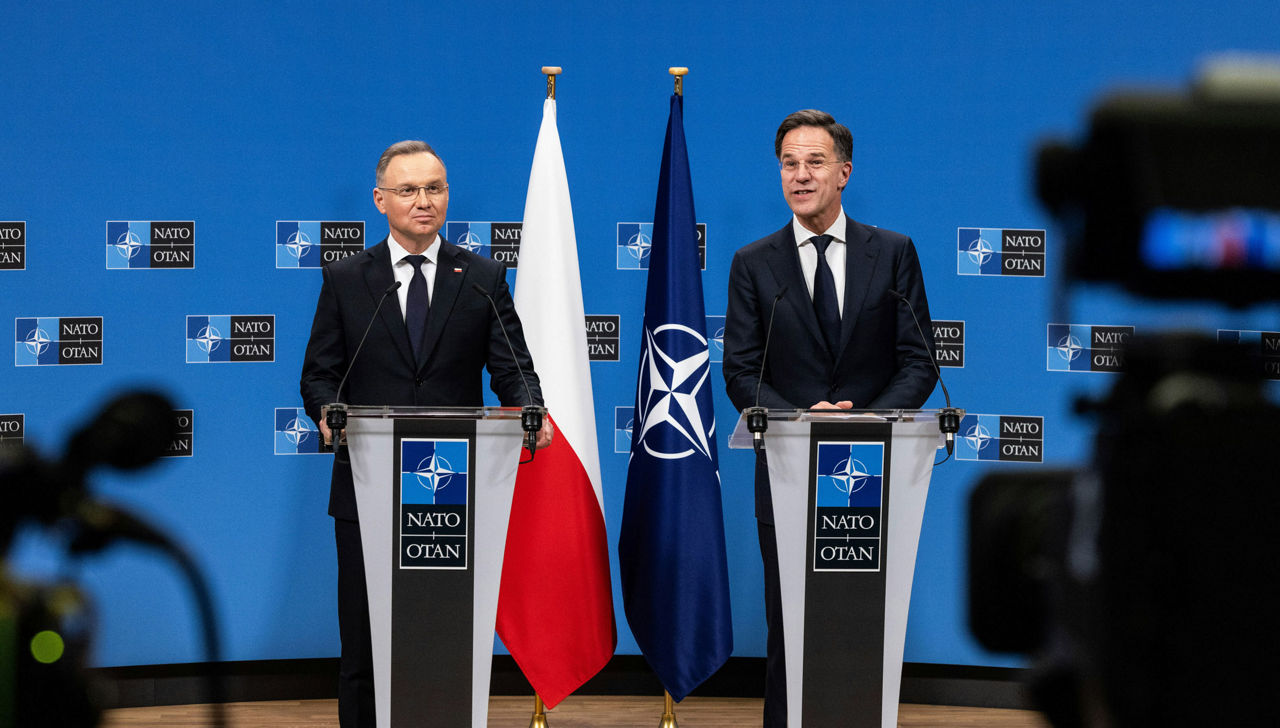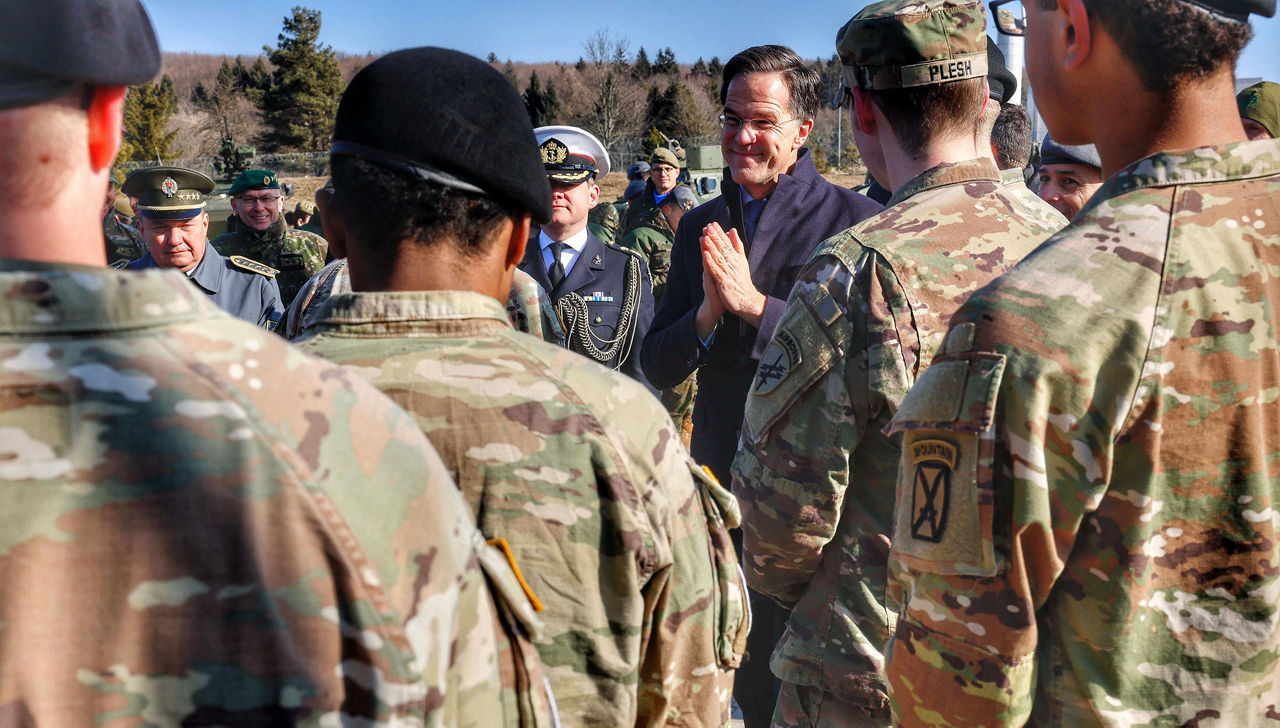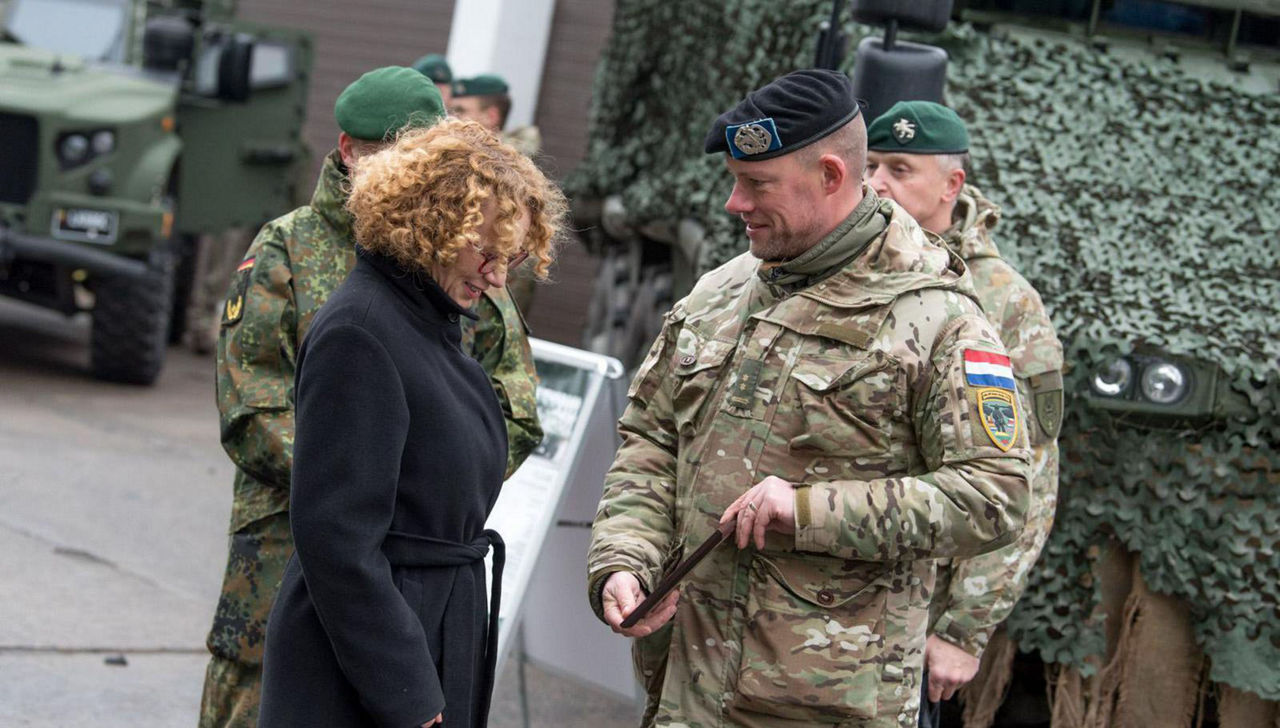Download NATO’s broadcast-quality video content free of charge

Log in
NATO MULTIMEDIA ACCOUNT
Access NATO’s broadcast-quality video content free of charge

Check your inbox and enter verification code
You have successfully created your account
From now on you can download videos from our website
Subscribe to our newsletter
If you would also like to subscribe to the newsletter and receive our latest updates, click on the button below.
Enter the email address you registered with and we will send you a code to reset your password.
Didn't receive a code? Send new Code
The password must be at least 12 characters long, no spaces, include upper/lowercase letters, numbers and symbols.
Your password has been updated
Click the button to return to the page you were on and log in with your new password.
Strengthening NATO’s eastern flank
Updated: 23 October 2025
Over the past decade, NATO has massively reinforced its deterrence and defence posture along its eastern flank, from the Arctic Ocean in the north to the Black Sea in the south. Russia’s illegal annexation of Crimea in 2014 and its full-scale invasion of Ukraine in 2022 have fundamentally changed the security environment in Europe, and its hostile actions towards NATO members and partners – including airspace violations, cyber attacks and acts of sabotage – are increasing in frequency. NATO has responded by significantly strengthening its readiness to protect and defend all Allies, with more combat-ready forces along the eastern flank and the most comprehensive defence plans since the end of the Cold War.
- NATO has increased its military presence along its eastern flank as a direct result of Russia’s behaviour, which reflects a pattern of aggressive actions against its neighbours and the wider transatlantic community. Russia is the most significant and direct threat to Allies’ security and to peace and stability in the Euro-Atlantic area.
- NATO’s Forward Land Forces consist of eight multinational battlegroups located in member countries along the eastern flank. The battlegroups vary in size and composition according to military requirements. They are based in Bulgaria, Estonia, Hungary, Latvia, Lithuania, Poland, Romania and Slovakia.
- NATO Integrated Air and Missile Defence protects Allies from airborne threats, including fighter jets and drones. This includes permanent NATO Air Policing, in which member countries help to monitor and patrol the skies of their fellow NATO Allies 24/7.
- The Alliance also conducts maritime activities on the eastern flank, including Baltic Sentry, which is strengthening the protection of critical undersea infrastructure.
- NATO is also enhancing its protection of Allies along the eastern flank in the cyber and space domains, and helping build resilience against Russia’s hostile actions.
- In September 2025, NATO launched Eastern Sentry, a flexible, multi-domain activity to enhance NATO’s vigilance along the entire eastern flank. Through Eastern Sentry, Allies are contributing additional capabilities and assets to NATO’s strengthened deterrence and defence posture.
- In addition to strengthening deterrence and defence in its own member countries, NATO continues to support Ukraine as it defends itself against Russia’s war of aggression. Ukraine’s security contributes to NATO’s security. NATO Allies will not be deterred by Russia from their enduring commitments to support Ukraine.
- NATO’s military activities along the eastern flank are entirely defensive. The Alliance is ready, willing and able to defend every Ally, and an attack against any Ally would be met with a resounding response.
NATO’s Forward Land Forces
NATO’s Forward Land Forces (FLF) are a key element of the Alliance’s military presence along the eastern flank. They are deployed in eight multinational battlegroups, located on NATO territory. The FLF are provided by framework nations and other contributing Allies on a voluntary, fully sustainable and rotational basis. Forces from contributing nations rotate in and out of the host nation; at any given time, they may be deployed to the battlegroups or stationed in their home countries with the ability to deploy rapidly, if needed. The battlegroups operate in concert with national home defence forces and are present at all times in the host nations.
All eight battlegroups are fully combat-capable formations, but they are not identical – their sizes and compositions are tailored to specific geographic factors and threats. Initially, the battlegroups were battalion-size units. In 2022, Allies agreed to deploy additional troops and scale up the battlegroups to brigade-size units, when and where required (although the formations are called “NATO multinational battlegroups”, regardless of size or organisational structure). Overall, military requirements guide each battlegroup’s composition.
Today, troops and personnel from all NATO Allies serve, train and exercise together in the east of the Alliance, representing a strong expression of unity and solidarity. NATO’s Forward Land Forces are defensive, proportionate, transparent and in line with the Alliance’s international commitments and obligations. They represent a significant commitment by Allies and are a tangible reminder that an attack on one NATO Ally is an attack on all.
NATO’s multinational battlegroups
As of October 2025, the eight battlegroups are composed of the following Allies:
Host nation: Bulgaria
Framework nation: Italy
Contributing nations: Albania, Croatia, Greece, Montenegro, North Macedonia, Türkiye and the United States
Host nation: Estonia
Framework nation: United Kingdom
Contributing nations: France
Host nation: Hungary
Framework nation: Hungary
Contributing nations: Croatia, Italy, Türkiye and the United States
Host nation: Latvia
Framework nation: Canada
Contributing nations: Albania, Czechia, Denmark, Iceland, Italy, Montenegro, North Macedonia, Poland, Slovakia, Slovenia, Spain and Sweden
Host nation: Lithuania
Framework nation: Germany
Contributing nations: Belgium, Czechia, Luxembourg, the Netherlands and Norway
Host nation: Poland
Framework nation: United States
Contributing nations: Croatia, Romania and the United Kingdom
Host nation: Romania
Framework nation: France
Contributing nations: Belgium, Luxembourg and Spain
Host nation: Slovakia
Framework nation: Spain
Contributing nations: Czechia, Portugal, Romania and Slovenia
Allies are continuing to integrate NATO’s newest members – Finland and Sweden – into plans, forces and command structures. This includes developing a presence in Finland, which Sweden has announced its intention to lead as the framework nation.
Command and control
All eight battlegroups are integrated into NATO’s command structure to ensure the necessary readiness and responsiveness.
The four north-eastern battlegroups (in Estonia, Latvia, Lithuania and Poland) are under NATO command through the Multinational Corps Northeast Headquarters in Szczecin, Poland. Two division-level headquarters coordinate training and preparation activities of their respective battlegroups. Multinational Division Northeast Headquarters located in Elblag, Poland has been fully operational since December 2018. This headquarters works closely with the battlegroups in Poland and Lithuania. A complementary Multinational Division North Headquarters was activated by NATO in October 2020 and has since reached full operational capability. Its forward elements are located in Adazi, Latvia, while the rest of the headquarters is located in Karup, Denmark. This headquarters cooperates closely with the battlegroups in Estonia and Latvia.
Regionally focused headquarters contribute to the operation of the four other battlegroups. This includes Multinational Division Centre Headquarters in Székesfehérvár, Hungary (for the battlegroups in Hungary and Slovakia) and both Multinational Corps Southeast Headquarters in Sibiu, Romania and Multinational Division Southeast Headquarters in Bucharest, Romania (for the battlegroups in Bulgaria and Romania).
In addition, many activities undertaken by Allies nationally – while not formally part of NATO’s forward presence – also contribute to increased Allied activity in the eastern part of the Alliance.
Rapid reinforcement
NATO’s rapid reinforcement strategy ensures that forward presence forces will be reinforced by additional high-readiness forces and NATO’s heavier follow-on forces, if necessary.
At the 2022 NATO Summit in Madrid, Allies agreed a new NATO Force Model, which represents a broader expansion of high-readiness forces potentially available to NATO where and when required.
Allies have also agreed to boost NATO’s ability to reinforce its forces in the east by developing:
- more pre-positioned equipment and weapon stockpiles;
- more forward-deployed capabilities, including integrated air and missile defence systems;
- strengthened command and control; and
- upgraded regional defence plans, with specific forces pre-assigned to the defence of specific Allies.
These pre-assigned forces will work with in-place forces – both national home defence forces and Allied Forward Land Forces – and become familiar with local terrain, facilities and pre-positioned stocks so that they can reinforce their Allies even faster.
NATO Allies continuously test and improve their rapid reinforcement capabilities through large-scale, multinational military exercises. During exercise Steadfast Defender 2024, NATO’s largest exercise since the end of the Cold War, the Alliance demonstrated its ability to rapidly deploy and sustain complex operations, with troops from North America crossing the Atlantic to reinforce Europe’s defence.
Integrated Air and Missile Defence
NATO Integrated Air and Missile Defence (NATO IAMD) protects Allies from air and missile threats emanating from all strategic directions, and stemming from both state and non-state actors. It includes a range of measures to deter actors from launching any air or missile threats, to detect any threat that has been launched, and to disrupt and destroy any threat that poses a challenge to Allied security. These measures include NATO’s 24/7 air policing, deployments of modern air defence systems, as well as ballistic missile defence systems. NATO IAMD is an essential element of NATO’s deterrence and defence posture, particularly focused along the eastern flank, contributing to the Alliance’s indivisible security and freedom of action, including NATO’s ability to reinforce its deployments and to provide a strategic response.
Learn more: NATO Integrated Air and Missile Defence
Learn more: NATO Air Policing
NATO’s maritime activities on the eastern flank
NATO's Standing Naval Forces (SNF) provide the Alliance with a continuous, credible and agile maritime capability that can be rapidly deployed in times of crisis or tension. Since Russia's full-scale invasion of Ukraine in February 2022, the SNF have been strategically deployed to strengthen the Alliance's maritime posture, including along the eastern flank.
The Alliance also conducts maritime activities in specific regions, enhancing deterrence and defence and helping to protect critical undersea infrastructure. For example, NATO Allies are countering destabilising acts in the Baltic Sea through the multi-domain activity Baltic Sentry. Since January 2025, Baltic Sentry has enhanced the security of critical undersea infrastructure by deploying a range of assets, including frigates, maritime patrol aircraft and a fleet of naval drones. NATO is working with Allies to integrate national surveillance assets, improving the ability to detect threats to critical undersea infrastructure and respond if required.
Learn more: NATO's maritime activities
Protecting against cyber and hybrid threats
In recent years, NATO Allies have experienced increasing cyber attacks, information threats, political interference, acts of sabotage, violations of airspace by fighter jets and drones, and other hostile actions. Through these coordinated activities, Russia and its proxies are trying to weaken the Alliance – to create fear, destabilise civil society, disrupt economic systems and deter support to Ukraine.
In response, NATO Allies are taking actions to strengthen the resilience of their societies and the protection of critical infrastructure, both individually and collectively. This includes not only multi-domain military activities like Baltic Sentry and Eastern Sentry (see other sections on this page), but also enhanced cyber capabilities and defences, and support to each other in the event of cyber attacks. NATO members are stepping up intelligence-sharing and surveillance across all domains – air, land, maritime, space and cyberspace – which is improving situational awareness and the coordination of responses to destabilising actions across the Alliance. Allies are also enhancing their preparedness for chemical, biological, radiological and nuclear threats, strengthening their energy security, and boosting resilience by using a range of tools and technologies to track patterns and trends that could indicate hostile actions.
Learn more: Resilience, civil preparedness and Article 3
Learn more: Countering hybrid threats
Eastern Sentry
Russia has been testing NATO’s resolve and responsiveness along the eastern flank for many years, and its reckless and escalatory actions have been increasing in recent months. This has included a growing number of airspace violations, which risk miscalculation and endanger lives.
In September 2025, an unprecedented number of Russian drones and planes violated the airspace of several NATO Allies – including incursions of Russian drones into Polish airspace and fighter jets in Estonian airspace, which led to security consultations under Article 4 of the North Atlantic Treaty.
In response, NATO launched Eastern Sentry, a flexible, multi-domain activity that is enhancing NATO’s vigilance along the entire eastern flank. Through Eastern Sentry, Allies are contributing additional capabilities and assets to NATO’s deterrence and defence – for instance, more fighter jets, helicopters, transport aircraft, air defence systems, surveillance aircraft and frigates – and improving the coordination of these assets through NATO. Furthermore, Eastern Sentry is building on the experience from Baltic Sentry and is incorporating innovative technologies and tactics to address new challenges.
Learn more: NATO launches “Eastern Sentry” to bolster posture along eastern flank
Evolution since 2014
NATO has increased its military presence in the eastern part of the Alliance as a direct result of Russia’s behaviour, which reflects a pattern of aggressive actions against its neighbours and the wider transatlantic community. Russia is the most significant and direct threat to Allies’ security and to peace and stability in the Euro-Atlantic area.
September 2014 – Following Russia’s illegal and illegitimate annexation of Crimea in 2014, Allies agreed at the 2014 Wales Summit to implement the Readiness Action Plan (RAP) in order to respond swiftly to the fundamental changes in the security environment on NATO's borders and further afield.
July 2016 – Building on the RAP, Allies took further decisions at the 2016 Warsaw Summit to strengthen NATO’s deterrence and defence posture and to contribute to projecting stability and strengthening security outside of Alliance territory. These decisions included the establishment of an enhanced Forward Presence (eFP) in the northeast of the Alliance, and a tailored Forward Presence (tFP) in the southeast. Together, these decisions represented the biggest reinforcement of Alliance collective defence in a generation. Combined with the forces and capabilities required for rapid reinforcement by follow-on forces, this forward presence has enhanced the security of all Allies.
August 2017 – In line with the 2016 Warsaw Summit decisions, by August 2017, four multinational battlegroups were deployed and fully operational in Estonia, Latvia, Lithuania and Poland. Allies also increased their activity in the southeast through a tailored presence on land, at sea and in the air to enhance situational awareness, interoperability and responsiveness.
November 2018 – In response to Russia’s actions in the Black Sea region in November 2018, NATO decided to increase its presence in the region to further improve situational awareness. Allies also stepped up their support for Georgia and Ukraine with more training and exercises for maritime forces and coast guards, as well as port visits.
February 2022 – Following Russia’s full-scale invasion of Ukraine on 24 February 2022, Allies further reinforced NATO’s deterrence and defence posture in the eastern part of the Alliance by deploying additional ships, planes and troops. This included thousands of additional soldiers to NATO’s battlegroups, fighter jets to support NATO air policing missions, bolstered naval forces in the Baltic and Mediterranean Seas, increased overall troop readiness and, for the first time, deployment of the highest-readiness element of the NATO Response Force to Romania.
March 2022 – At the extraordinary NATO Summit in Brussels on 24 March 2022, Allied Heads of State and Government agreed to establish four more multinational battlegroups in Bulgaria, Hungary, Romania and Slovakia. The establishment of four more battlegroups, together with the reinforcement of the existing four battlegroups in the northeast, extended the Alliance’s forward presence along NATO’s eastern flank – from the Baltic Sea in the north to the Black Sea in the south – and effectively doubled the number of troops on the ground.
June 2022 – At the 2022 Madrid Summit, Allies agreed to deploy additional forces to the Alliance’s eastern flank, scaling up their presence beyond the battalion-size multinational battlegroups to brigade-size units, where and when required. Allies also agreed a new NATO Force Model that includes more troops at high readiness and further measures to boost NATO’s ability to reinforce Allies in the east.
July 2023 – At the 2023 Vilnius Summit, Allies approved a new generation of regional defence plans, which are significantly improving the coherence of NATO’s collective defence planning with Allies’ national planning of their forces, posture, capabilities, and command and control.
April 2024 – Germany began deploying additional troops to the multinational battlegroup it leads in Lithuania, laying the groundwork for scaling up its presence from battalion to brigade size. These troops are setting up a permanent German military base in Lithuania. The German-led brigade was inaugurated in May 2025. It will continue to scale up and will be fully operational with up to 5,000 troops by 2027.
July 2024 – Latvia became the first country to scale up its NATO forward presence to a brigade, as NATO Multinational Brigade Latvia was stood up with Canada as the framework nation. In October 2024, the multinational battlegroup was transferred from the Latvian Mechanized Infantry Brigade to NATO Multinational Brigade Latvia. Canada plans to complete the full implementation of persistently deployed brigade capabilities to Latvia by 2026, at which point it will have up to 2,200 Canadian troops stationed in the multinational brigade.
July 2024 – Spain took command of NATO’s multinational battlegroup in Slovakia, which has showcased its ability to quickly form a multinational combat brigade in less than 10 days. Allies are also exercising their ability to rapidly reinforce the battlegroups in Bulgaria and Romania up to brigade level.
September 2024 – Sweden announced its intention to assume the framework nation role in the enhanced forward presence in Finland.
January 2025 – Following several incidents involving critical undersea infrastructure in the Baltic Sea, NATO launched the enhanced vigilance activity Baltic Sentry.
September 2025 - Russian drones and planes violated the airspace of several NATO Allies, including Estonia, Finland, Latvia, Lithuania, Norway, Poland and Romania. In response, NATO launched Eastern Sentry, an enhanced vigilance activity bolstering NATO’s posture along its eastern flank.
NATO’s forward presence along the eastern flank demonstrates the Alliance’s solidarity, determination and ability to act immediately in response to any aggression. Training and exercises in support of NATO’s forward presence give Allied forces experience working together, resulting in enhanced readiness and interoperability.
The security environment in the Euro-Atlantic area continues to evolve and new threats and challenges are constantly emerging. The Alliance adapts and plans accordingly, and its forward presence will remain as long as the security situation requires it. The Alliance will continue to ensure that its posture remains credible, coherent and resilient. All NATO measures are and will remain defensive, proportionate and consistent with international commitments. The Alliance will maintain the transparency that has characterised its forward presence since its inception.






